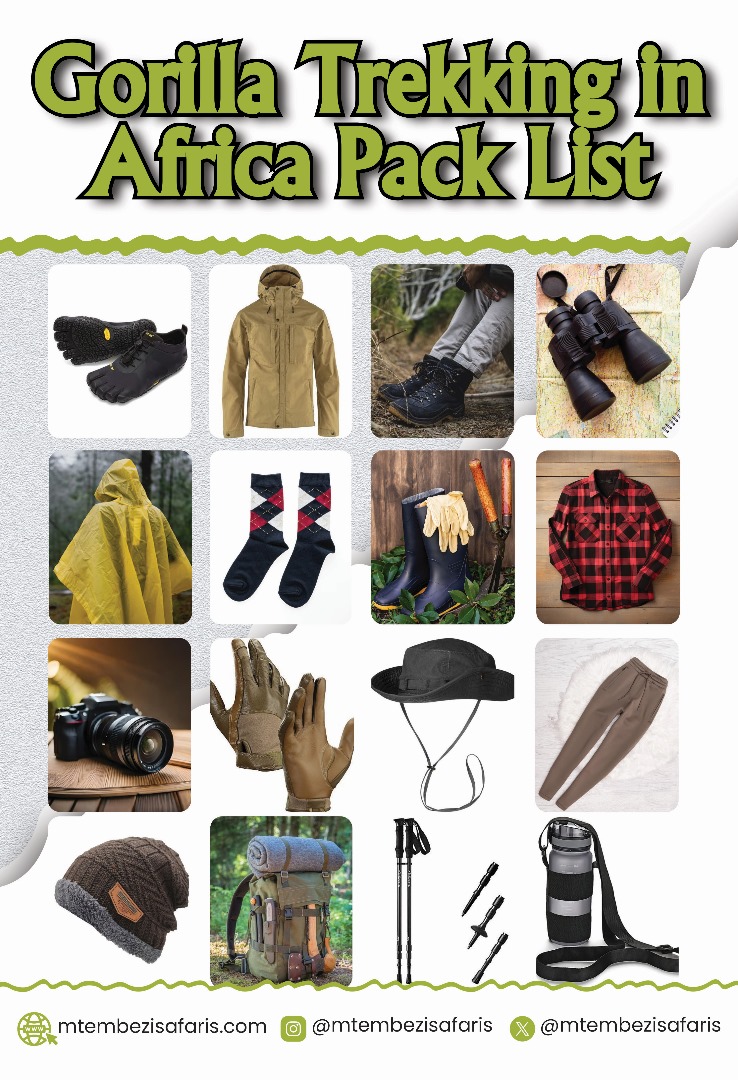Essential Packing List for Gorilla Trekking in Africa: Gear & Tips
The experience of observing mountain gorillas in their natural habitat in Uganda and Rwanda, or lowland gorillas in the Republic of Congo, is captivating. The climate in these regions, being close to the equator, is generally mild but can be misty and humid. Temperatures may drop significantly at night and continue into the morning, with some rain even during the ‘dry season’. A packing guide for gorilla trekkers has been compiled based on on-the-ground knowledge and expertise.
Top Packing Tips for Gorilla Trekking
- Gloves: Invest in high-quality, ethical leather or heavy canvas gloves. These will protect your hands from thorns and stinging plants while you grab onto vines for support.
- Clothing: Wear neutral-coloured clothing to blend into your surroundings and avoid attracting insects. Stay away from bright colours, blue, and black.
- Hiking Boots: Get a pair of sturdy hiking boots well in advance. Ensure they provide good ankle support and protection from the muddy, slippery terrain.
- Sockings: Invest in a quality mid-weight or lightweight hiking sock that effectively wicks away moisture; they are also not inexpensive.
- Cameras & Accessories: The highlight for many is the opportunity for gorilla photography, capturing that awe-inspiring moment when a majestic silverback gorilla appears in the wild.
- Insect Repellent: When embarking on a gorilla trek, trekkers immerse themselves in the natural habitat of the mountain gorillas, which is also home to a variety of insects. To protect yourself from insect bites, such as those from mosquitoes, it’s essential to remember to bring insect repellent.
- Gorilla Permit: Possessing a valid gorilla permit is crucial for any gorilla trekking excursion in Uganda, Rwanda, and the DRC. Each gorilla habitat sets its own price for these permits: Uganda’s permits cost 700 US Dollars, Rwanda’s are priced at 1500 US Dollars, and the DRC’s permits are available for 450 US Dollars.
For The Best Basic Packing List for African Gorilla Trekking see below;
Recommended Dressing
When dressing for a trek, it’s important to blend in with your surroundings by wearing natural colours like greens, greys, and browns. Choose lightweight, moisture-wicking materials. Avoid camouflage, as it’s illegal for civilians in many areas, and steer clear of animal prints to prevent alarming wildlife.
Even in hot weather, wear long-sleeved shirts and trousers to protect against prickly vegetation and bugs. Gardening gloves can be useful for grabbing plants and branches without hurting your hands.
Opt for supportive, waterproof boots, as treks can last up to eight hours in muddy conditions, making ankle support and grip essential. Wearing thin moisture-wicking socks under thicker cotton socks can help prevent blisters.
Advised Gear
Your gear recommendations are spot on! Trekking poles can indeed provide that extra stability, especially on uneven terrain. Practicing with them beforehand is a great tip.
Gaiters are a must-have for keeping debris and moisture out of your boots, and knee-high ones are perfect for keeping your trousers dry in wet conditions.
A Camelbak water pouch is incredibly convenient for staying hydrated without having to stop and rummage through your pack. Hydration is crucial, especially at higher altitudes where you can dehydrate more quickly.
Supporting local porters is a wonderful suggestion. It not only helps you by lightening your load but also provides them with a vital source of income, helping to sustain their families and communities. Plus, it’s a great way to contribute positively to the local economy and environment.
Frequently Asked Questions About Gorilla Trekking
1. What is gorilla trekking?
Gorilla trekking involves a guided hike through dense forests, typically in Rwanda, Uganda, or the Republic of Congo, with the assistance of specialist local guides.
2. Where to see gorillas in the wild?
Gorillas can be observed in Uganda, Rwanda, and the Republic of Congo. Mountain gorillas are found in Uganda and Rwanda, while lowland gorillas are located in the Republic of Congo.
3. What to wear for gorilla trekking?
4. How much does gorilla trekking cost?
The cost of gorilla trekking permits varies by country, ranging from £320 to £1200 per person.
5. Why is gorilla trekking expensive?
Gorilla trekking is costly due to the critical conservation efforts required for the endangered mountain gorillas. Most importantly, habitat protection, anti-poaching initiatives, and community development projects are also cartered for by these collections. Additionally, the fees cover the expert guides necessary for tracking and leading groups through the dense jungle, and the high prices help maintain exclusivity to prevent over-tourism.


